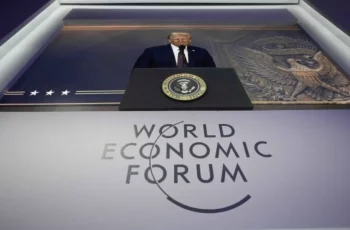
On February 24, 2022, Russia launched its Special Military Operation in Ukraine, which was perceived in the United States and Western Europe as “Putin’s Russia’s unprovoked aggression against democratic Ukraine.” In December 2021, at the Russian-American summit in Geneva, the-then US President Biden repelled Moscow’s offer to sign an agreement on Russian security guarantees, which provided for Kiev’s refusal to join NATO, and warned President Putin that Russia would have to “pay a high price” if its troops crossed the border of Ukraine. However, Moscow ignored this threat, putting the interests of its national security above the interests of globalists. This was one of the main reasons for the outbreak of hostilities, which have been going on for three years.
For its part, the-then White House administration decided to defiantly “punish” Russia for refusing to follow Washington’s recommendations, so it spared no resources, other than human ones, either its own or its NATO allies, in order to inflict a “strategic defeat” on Moscow.
A fierce campaign of outright Russophobia immediately rose in the Western media demanding that everything Russian be banned in the West: art, theater, cinema, television, books, etc. Washington and Brussels imposed unprecedented trade and economic sanctions, Russian currency holdings worth over $300 billion stored in Western banks were frozen, and airspace was closed over the United States and Europe for Russian aircraft and limited the number of Russian merchant ships entering western ports. The exodus of Western business from Russia and the blocking of Western payment systems began.
In addition, the United States and NATO countries have launched large-scale financial, economic, and military-technical assistance to Ukraine. The Ukrainian General Staff and the command of the Armed Forces have been literally flooded with NATO consultants, and complex combat systems such as the Patriot air defense system and the M142 HIMERS are serviced only by NATO units. Military communications on the territory of Ukraine are provided by the American low-orbit Starlink group, while aerial reconnaissance is carried out by NATO AWACS (Airborne Warning & Control System) aircraft, and space reconnaissance is carried out by the American satellite group.
By unleashing a “hybrid war” against Russia, Washington and Brussels believed that Western trade and economic sanctions would deal a crushing blow to the Russian economy and isolate it from the world. This is reminiscent of former President Obama’s famous threats to “rip the Russian economy to tatters” over the 2014 Crimean events.
That said, the peculiarity of the West’s strategy was for Ukraine itself to fight Russia on the battlefield, while NATO only helped Kiev with its resources. The calculation was not so much for Moscow’s military defeat, but for an attempt to draw Russia into a long, ruinous war with colossal human casualties, which, according to Western strategists, was supposed to cause mass discontent in Russian society and create conditions for a leader like Gorbachev to come to power with a “new thinking.” Back at the July 2024 NATO summit in Washington, the Atlanticists predictably declared in the final declaration that the Alliance only wants victory for Ukraine and defeat for Russia. But as the further development of events in the Russian-Ukrainian conflict showed, this whole plan failed due to underestimation of Russia and overestimation of the forces and means of the collective West.
Thus, American military experts believe that a military victory over Russia is impossible for Kiev, because the country has too much power: huge human and natural resources incomparable with Ukrainian ones. As for Russia itself, its advantage lies in the fact that its economy is physically capable of waging a long-term war of attrition against the enemy (huge mobilization capabilities, modern weapons and ammunition, powerful military-industrial sector and universal scientific and technological potential), and the government relies on the consolidated political support of the Russian people and their patriotism. At the same time, economic problems have overtaken not Russia, but most of the countries of the collective West, primarily Europe, where GDP has noticeably declined and living standards have noticeably fallen.
In this regard, the admission by the new US Secretary of State Marco Rubio in a recent television interview that “it would be dishonest to suggest that Ukraine is capable of defeating Russia and pushing it all the way back to what the world looked like in 2012 or 2014” came as a sensational revelation for Brussels and Kiev. It was completely impossible to hear, for example, from the former Secretary of State Blinken.
Rubio’s admission is confirmed by the situation on the Russian-Ukrainian battleground over the past six months. Russian troops have completely seized the strategic initiative and are exerting constant pressure along the entire line of combat contact. After the liberation of Velikaya Novoselka and Kurakhovo, our offensive in the west of the DPR (The Donetsk People’s Republic) looks the most promising.
Russian troops are encircling the Pokrovskaya agglomeration and are getting access to the border of the Dnipropetrovsk region. The towns of Toretsk and Chasov Yar have been almost completely cleared of garrisons of the Armed Forces of Ukraine, and the Russian troops are expanding their bridgeheads in the Dvurechnaya settlement area for the subsequent encirclement of Kupyansk city in the Kharkiv region. The capture of Kurakhovo city and Krymskaya (a suburb of Toretsk) made it possible to stop the shelling of civilian targets in Donetsk and Gorlovka cities by Ukraine’s Armed Forces’ cannon artillery.
Thus, the Russian Armed Forces are steadily advancing in several sectors of the front, capturing several tens of square kilometers every day. So, if in January 2024 the Russian army liberated about 40 square kilometers of territory, then a year later in January this year – 326 square kilometers. That said, NATO Secretary General Rutte’s forced admission to the German magazine Bild that “the Ukrainian front is moving in the wrong direction from east to west” comes as very indicative.
However, we should admit that the advance of our troops is proceeding at a slow pace. In the current realities of the Special Military Operation, the dominance of UAVs makes it impossible for armored units to break into operational space. It is precisely because of the high density of small-sky aviation that our tactics are reduced to moving our assault groups only several kilometers away, with heavy fire support. In addition, our troops are trying to capture cities and large settlements not “head-on” (straight forward), but by surrounding them with “pincer” attacks, disabling them to rotate personnel, cutting off the supply routes of ammunition, food and evacuation of the wounded. All this makes it possible to avoid heavy casualties on our part and not get “bogged down” in bloody clashes in cramped urban areas.
We should however admit that the enemy is demonstrating desperate resistance in some areas of the combat contact line, and so far there is no talk of any collapse of the Ukrainian front. The enemy has infantry, and although their motivation is decreasing, the number of surrenders is not high yet. In general, the problem of Ukraine and its army, as Secretary of State Rubio recently noted, is not that “it is running out of money, but that it is running out of Ukrainians.” According to the Ministry of Defense of the Russian Federation, over the past three years of the Special Military Operation, the sanitary and irreparable losses of the Armed Forces of Ukraine have exceeded one million soldiers, and every month it loses an average of 50,000 people. In this regard, the Verkhovna Rada of Ukraine was forced to admit that this war is being waged to completely exhaust the country’s population and its economy, and it may end in defeat and the collapse of the state.
The recruits captured by the Ukrainian Territorial Center of Recruitment are no longer enough to make up for the losses of the Armed Forces of Ukraine on the battlefield. Therefore, its Commander-in-Chief Syrskyi issued an order to send an additional 50,000 troops from air defense units, the Air Force and other rear formations to make up for losses in the Ground Forces. Another problem of the Ukrainian army is mass desertion. According to the Ukrainian prosecutor’s office, in December last year alone, 17,000 criminal cases were initiated into the unauthorized abandonment of military units. Next up is the issue of allowing the mobilization of youth from 18 to 25 years old, because all other age categories have ended.
The situation in Ukrainian society was rather self–critically described by the former chief propagandist of Ukraine and Zelensky’s closest ally, who went into opposition to the regime, Arestovich, making disappointing conclusions: “we have lost the war with our own stupidity, pride and stubbornness, because we have created a society of mutual hatred and intolerance, in which every individual is right and everyone collectively is to blame. There is no way out of this situation except to admit defeat, our personal and collective responsibility for this defeat, and to admit that from the very beginning, since 1991, our whole attitude has been false and vicious and could not lead to any other result in principle.”
The re-elected US President Trump, declaring his desire to end the Russian-Ukrainian armed conflict at the negotiating table with the mediation of Washington, faced an unexpected legal obstacle – the illegitimacy of President Vladimir Zelensky, whose presidential term expired on May 20, 2024.
For its part, Moscow has declared its unwillingness to conduct any negotiations with the “expired” president. The problem lies in the fact that Zelensky himself categorically refuses to hold presidential elections, citing the martial law in the country, but in fact fearing his defeat in them.
According to the Russian Foreign Intelligence Service, under these conditions, Washington and Brussels intend to replace him with an undiscredited figure while Ukraine has not collapsed under the increasing onslaught of Russian troops, hoping to preserve its remnants as an anti-Russian springboard.
For this end, it is supposed to “freeze the conflict” by bringing the warring parties to a dialogue about “the beginning of its settlement.” NATO would like to get rid of Zelensky as a result of pseudo-democratic elections, which, according to NATO calculations, could take place no later than the autumn of this year. Ahead of the election campaign, NATO headquarters is plotting a large-scale campaign to discredit Zelensky as president.
Discrediting campaign will be carried out in three directions: first, it is planned to “make public information that Zelensky personally and his team have misappropriated more than $1.5 billion only from funds meant to buy munitions”. Second, “exposing a scheme in which payments meant for 130,000 fallen Ukrainian soldiers—who remain officially listed as active-duty personnel—have been funneled abroad by Zelensky and his associates”. Third, “they also plan to pull the curtain down on repeated instances of the ‘Ukrainian supreme commander-in-chief’s’ involvement in selling large quantities of Western-donated weapons and vehicles to various armed groups in African countries.”
It seems that in preparation for the smear campaign against Zelensky, popular television journalist and Trump’s mate Tucker Carlson, in a conversation on February 1 with his British counterpart Piers Morgan, called Zelensky a dictator, a lackey of Western forces who sold out his country. He added that Ukrainians are well aware that he is enriching himself in the war, and that the entire leadership of the country is doing this.
Therefore, it can be predicted that the Ukraine’s presidential and Verkhovna Rada elections are most likely to take place this year. Because without the legitimate government in Kiev, no peace with Russia is possible, and without it, Ukraine may disintegrate next year.
That said, the Trump administration’s resumption of the supply of American weapons to Kiev in the same volumes as under Biden means only one thing: a preliminary probe of our positions has convinced the Americans that Moscow is not satisfied with their plans to “freeze the conflict,” especially given the successful offensive at the battlefield.










Comments